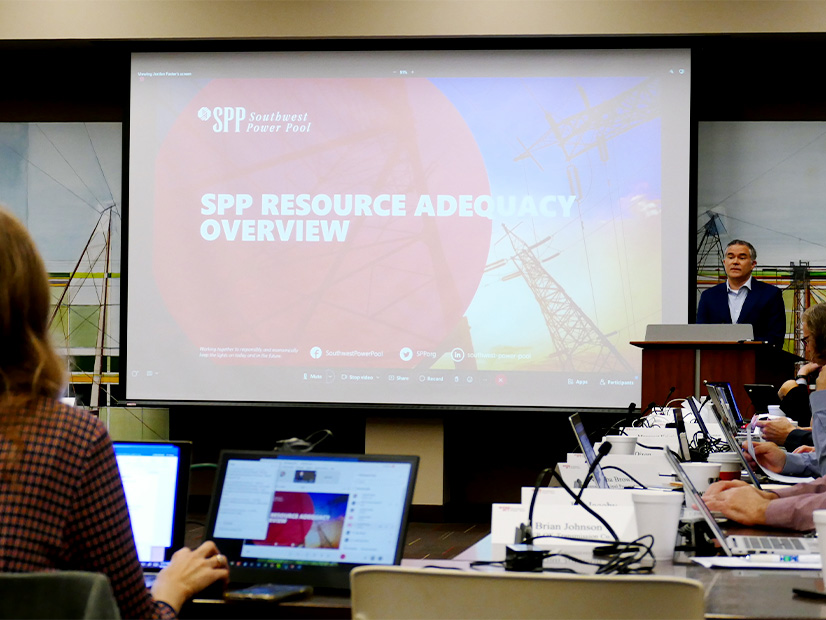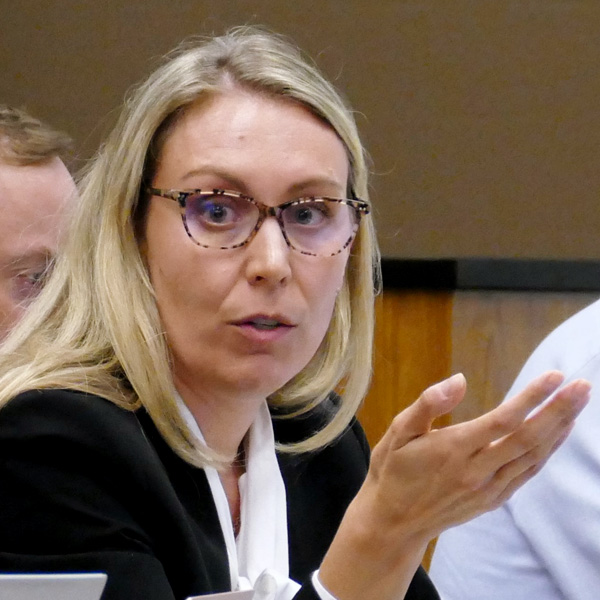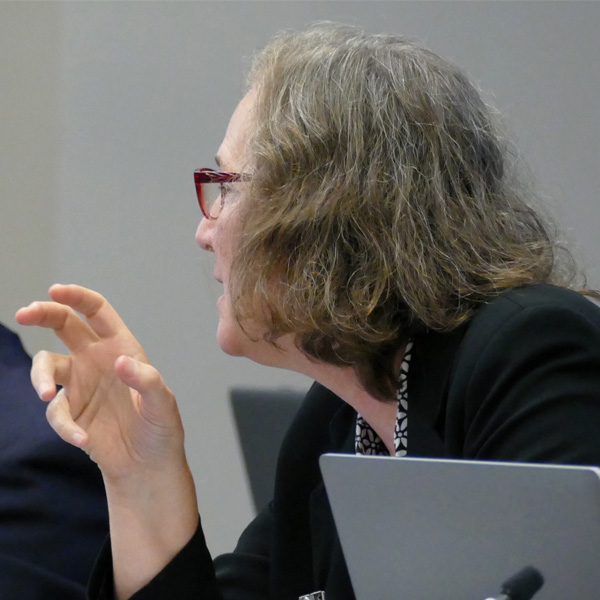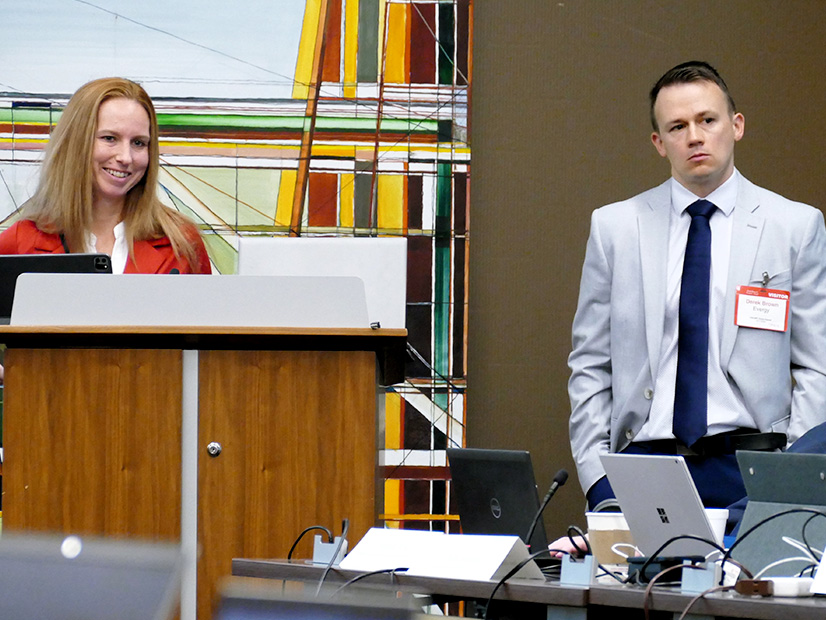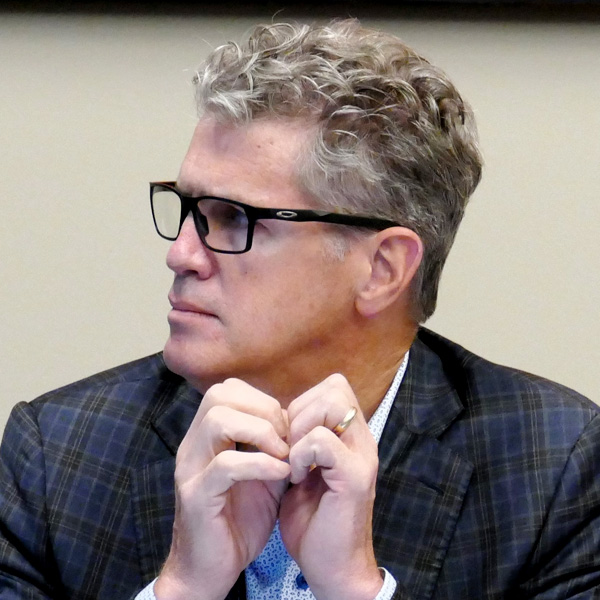LITTLE ROCK, Ark. — SPP stakeholders last week approved two revision requests following a lengthy discussion that set resource adequacy policies.
The Markets and Operations Policy Committee first rejected a compromise position recommended by two stakeholder groups. They urged that one of the two revision requests, which details SPP’s proposed performance-based accreditation (PBA) policy (RR554), be modified to use seven years of historical data, rather than 10, in calculating conventional resources’ accredited capacity.
That motion received only 57% approval during MOPC’s two-day meeting. Replacing the seven years of historical data with 10 years resulted in 84% approval for RR554 and RR568, which lays out an effective load-carrying capability (ELCC) policy, with all 14 transmission owners voting yes.
RR568 is a response to FERC’s rejection earlier this year of SPP’s first attempt to add ELCC (the amount of incremental load a resource can dependably and reliably serve during peak hours). The revision reduces a three-tiered structure to just two, firm and non-firm transmission service. Staff will study only firm service in its ELCC analysis. (See FERC Grants Rehearing of SPP Capacity Accreditation Proposal.)
SPP’s Market Monitoring Unit initially proposed five years of historical data but settled on the seven-year compromise during a September meeting with the Resource and Energy Adequacy Leadership (REAL) Team. (See SPP REAL Team Compromises on PBA, ELCC Revisions.)
“It’s important that we have an accurate assessment of historical performance. We feel that [five years] is a much more accurate representation of an assessment period,” MMU’s executive director, Keith Collins, said. “As you think about going forward, are you doing things to improve the performance of your resource?”
Smaller utilities sided with the 10 years of historical data, saying it would give them and their smaller fleets more time to meet resource requirements.
“They’re facing an entirely different risk profile in this RTO going forward, and that can’t be overstated enough. The risk now is substantial in the loss of a unit over a period of time,” Golden Spread Electric Cooperative’s Mike Wise said.
“It is a balancing act,” SPP’s Casey Cathey, senior director of grid asset utilization, said. “It’s a question of if we can provide more accurate, responsible performing resources through maybe a shortened timeframe, then that might lessen the socializing of an increase in [planning reserve margin]. But to the extent that we can better accredit those resources, then it more accurately applies that to the individual resources as opposed to socializing them.”
MOPC also approved a Supply Adequacy Working Group policy paper on demand response (DR) that will be converted into a revision request and the stakeholder group’s direction on fuel assurance. Both motions passed with more than 91% approval.
The SAWG plans to develop a policy that facilitates diverse DR programs by considering the potential for increases in large loads that may claim its accreditation. Its members say SPP must accurately accredit DR resources according to their reliability contribution and develop qualification standards to drive consistency.
The group also voted to develop policy that incorporates PBA weighting based on critical system periods and considers modifications to the out-of-management-control exceptions related to fuel-related outages. The SAWG also will consider a policy for PBA and ELCC adjustments to reflect new reliability investments and it recommends SPP improve operational dispatch strategies to start units before extreme cold weather and keep them online.
Cathey said he hopes the changes can be implemented before the 2026-27 winter season.
Sunflower Waiver Request Rejected
Members rejected Sunflower Electric Power’s request that four byway transmission upgrades be allocated 100% to the entire pool, based on their regional use, under a cost-allocation methodology that FERC rejected earlier this year.
SPP’s largest transmission owners pushed back against the measure, saying allocating costs of existing facilities should not be done on an ad hoc basis by the RTO’s state regulators. They said deconstructing the grid operator’s highway/byway process with one-off reassignments sets a troubling precedent for future requests.
Eight of 12 TOs voted against the measure and six others abstained. Half of the transmission users voted for RR584. It failed with 50.8% approval.
“There’s no actual methodology associated with this. This is just some power facilities being moved into the tariff and being elevated to highway funding without clear direction or a repeatable process also being applied to it,” Southwestern Public Service Co.’s (SPS) Jarred Cooley said. “We at SPS are very concerned that this is going to set an ad hoc precedent on how cost allocation is performed moving forward on an ad hoc basis. It’s a repeatable process and without a methodology or a firm waiver process.”
FERC in July unanimously reversed a 2022 decision that established a process for SPP to allocate “byway” transmission projects on a case-by-case basis without prejudice. (See FERC Reverses Course on SPP Byway Cost Plan.)
Sunflower, a “wind-rich” cooperative that long has felt unduly burdened with transmission costs for renewable energy that benefits others, has filed a rehearing request with FERC and asked the U.S. Court of Appeals for D.C. to review the case (ER22-1846).
The cooperative submitted its waiver in November 2022 from SPP’s base-plan allocation methodology for upgrades between 100 kV and 300 kV, or byway projects. The process allocates one-third of the cost of byway projects to the RTO’s full footprint, with customers in the transmission pricing zone where the project is built being allocated the rest. “Highway” projects — those larger than 300 kV — are allocated RTO-wide.
The Cost Allocation Working Group (CAWG) approved Sunflower’s waiver request in May. In September, it recommended to SPP state regulators that they approve and send to the board a revision request (RR584) allowing SPP to make a Section 205 filing at FERC that permits the four Sunflower upgrades be regionally allocated on a prospective basis.
The Regional Tariff Working Group approved RR584 later in September in a 9-5 vote, with five abstentions.
SPP’s Ben Bright, the CAWG’s staff secretary, said the group intends to continue working on the issue with the Regional State Committee (RSC), which has ultimate decision-making authority over SPP’s rates.
“The filings at FERC are still in limbo,” Bright told the MOPC. “Once those are more complete, then we will take up looking at a more comprehensive process, whether that be in the form of a waiver or just some sort of an assessment.”
The CAWG intends to make the same recommendation during the next RSC meeting.
Project Withdrawn, ITP Passes
MOPC approved two stakeholder groups’ (Transmission Working Group, Economic Studies Working Group) 2023 Integrated Transmission Plan (ITP) and its 10-year assessment , but not before members withdrew a $92 million, 48-mile, 115-kV joint economic project in Nebraska between the Western Area Power Administration’s Rocky Mountain Region and the Nebraska Public Power District.
The TWG’s motion failed with 53% approval when the project was included but passed with 97% approval when it was removed. The move gives SPP staff more time to find the right solution.
The Municipal Energy Agency of Nebraska’s Brad Hans motioned to add a notice to construct (NTC) for the Alliance-Victory Hill project. According to the assessment, the line would be congested by several elements in the area. Staff evaluated several alternatives, but timely rebuilds would be with non-SPP facilities, limiting viable solutions.
The 2023 ITP addresses reliability and economic issues on its seams. It recommends NTCs for 44 projects. The portfolio includes 150 miles of new transmission — 51 miles for 345-kV lines — and 93 miles of rebuild for a total engineering and construction cost of $735.5 million and a reduced 40-year adjusted production cost of nearly $3 billion.
Natalie McIntire, representing the Sustainable FERC Project and Natural Resources Defense Council, compared the portfolio’s size with that of recent MISO portfolios approaching $10 billion and suggested a third more aggressive future be used.
“The levels of expected increase in electrification [and] the rapid change in our generation mix across the country, seem to me to indicate that we’re going to need a lot more transmission. We’re going to need a much more robust grid,” she said. “I’m just concerned that SPP is going to find themselves behind the eight-ball in terms of meeting their members’ needs and maintaining a reliable system under this transition that we’re going through.”
Natasha Henderson, SPP’s director of system planning, said the grid operator has been doing economic planning for “some time,” resulting in small portfolios. She agreed the RTO must use accurate study inputs and said some of the more aggressive forecasts she’s seen for electrification triples the load.
“That makes my heart stop,” she said. “I stopped breathing for a little bit when I think about where we are and where we might be. I can’t necessarily say that, ‘Yeah, we’re going to triple the load by X time,’ but we really need to think about how we can proactively plan going forward.”
As is, the assessment says wind growth continues to outpace ITP projections. The 2023 ITP’s emerging technologies case projects 46.1 GW of in-service wind in 10 years, a nearly 25% increase from the 10-year assessment just two years ago. SPP had 37.1 GW of in-service wind resources when 2023 began.
MOPC also endorsed:
-
- The TWG’s recommendation to modify the shortfall process for both the 2024 ITP and the 2025 ITP for Year 10 summer. SPP developed the process to address the potential for a network customer’s load to exceed their available designated network resources, The changes include using expected conventional resource additions from the generator interconnection queue, ensuring the replacement process is considered for current planned retirements and increasing firm service renewable amounts based on alternative historical time periods.
- The PCWG’s proposal for a $12.3 million (47%) baseline increase for an American Electric Power-Oklahoma Gas & Electric 345-kV project in Oklahoma. The project’s costs escalated because a substation will need to be built nearly two miles farther than originally sited. “There’s not a lot of flat area in a canyon location,” OG&E’s Mark Barbee explained.
Update Delays Reduced
AEP’s Brian Johnson, the PCWG’s chair, said stakeholders, staff and the MMU have spent much of this year addressing transmission upgrade delays that have frustrated some renewable energy developers.
A revision request (RR574) is wending its way through the stakeholder process. It refines the task of identifying project in-service dates when a notification to construct is accepted and establishes routine project updates to stakeholders and governance groups and advanced notification of delays.
“Transparency and situational awareness … we’re looking for increased accuracy from [transmission operators] in that quarterly update,” Johnson said, noting project costs often have been the focus instead of service dates.
EDP Renewables’ David Mindham said it was apparent SPP is doing a “really, really good job” of building the construction it commits to and thanked Johnson for the work, but asked SPP be given more authority in the process.
“A lot of us have made very large investment decisions based on those transmission upgrades coming into service … Those upgrades need to be prioritized and SPP needs to have the authority to help mitigate those issues and, if the TO cannot build it for whatever reason, find a way to reassign that,” Mindham said. “I think it’s worthy of a discussion in this forum because we need more than just transparency. We need a clear message that these transmission lines are important. They’ve been approved by the SPP board to benefit SPP consumers and they need to be built.”
“When you have a project that is delayed and maybe causing economic issues, there’s a cost to that,” Johnson responded. “If there are alternatives available, maybe they cost some more money but save you time, those need to be vetted and understood and an informed decision made.”
Up to $610M in Annual RTO West Savings
Bruce Rew, senior vice president of operations, said SPP will see between $100 million and $610 million in annual value when its RTO West goes live in April 2026, primarily through the better use of seven DC ties the grid operator would manage between the Eastern and Western Interconnections.
SPP secured RTO West commitments in September from nine utilities, culminating three years of work with western parties. SPP’s Board of Directors already has approved 15 terms and conditions for new members. (See WAPA, Basin Electric Commit to SPP’s RTO West, “Board OKs Western Expansion, GI Queue Plan,” SPP Board of Directors/Members Committee Briefs: July 26-27, 2021.)
SPP’s expansion into the West will result in a single balancing authority with two BA areas under a single tariff, Rew said. The SPP West BAA will operate as a member of the Western Power Pool Reserve Sharing Group. Single-market solutions will be optimized across the DC ties’ 510 MW of bi-directional capacity.
Several West-only working groups will be formed to help draft the estimated 15 revision requests that will go into the initial tariff changes that will be filed next year at FERC. Accommodating western differences in planning reserve margins and resource adequacy requirements will necessitate several supplemental filings.
“You will begin seeing a lot of engagement at the working group level,” Rew said. “There’s definitely a lot of work to do between now and April of 2026.”
Alluding to an image of the ceremonial golden spike ceremony marking the first transcontinental railroad’s completion in 1869 that Rew included in his presentation, MOPC chair Alan Myers asked, “Do you get to drive the Golden Spike when this comes together?”
Rew demurred, saying that task likely would fall to CEO Barbara Sugg.
JTIQ Costs Up to $1.67 Billion
SPP staff said the cost of its joint targeted interconnection queue (JTIQ) portfolio with MISO has increased from $1.06 billion two years ago to an “updated estimate” of $1.67 billion. That is staff’s rough attempt to reflect the total costs submitted in its Department of Energy funding application and adjusting for a replacement project.
“Just a caveat, we’ve refreshed these costs and benefits numbers, but they shouldn’t be necessarily considered final. They’re simply estimates of costs and benefits,” said Clint Savoy, manager of interregional strategy and engagement.
The JITQ portfolio and its five transmission lines was one of several grid resilience and improvement projects to be awarded DOE funding last week from the Infrastructure Investment and Jobs Act. (See DOE Announces $3.46B for Grid Resilience, Improvement Projects.)
MISO and SPP staff will hold a joint stakeholder meeting on the JTIQ proposal in November and bring a revision request to January’s MOPC meeting. Kelley said the RTOs will file three tariff revisions at FERC: one for each grid operator and the third to revise their joint operating agreement.
SPP Membership Now 111
MOPC welcomed SPP’s newest two members, non-transmission owning members Pine Gate Renewables and Sierra Club. North Carolina-based Pine Gate was the latest to join the RTO, doing so last Friday.
SPP now has 111 members. They include 22 generation and transmission cooperatives, 20 independent power producers, 16 investor-owned utilities, 13 municipal systems, six state agencies, 13 independent transmission companies, 11 power marketers, four large retailers, three public-interest entities, two alternative power entities and one federal agency.
Annual VRL Analysis Endorsed
The committee’s consented agenda endorsed the 2023 annual violation relaxation limits analysis; aligning the PCWG’s scope with business practice language that adds transmission service projects where the cost is 100% directly assigned to one or more customers as an applicable project it can review; and a more than $16 million decrease (20.2%) for a Basin Electric 230-kV project in North Dakota.
The consent agenda also included 13 RRs that would:
-
- RR556: Clarify market participants registering auxiliary load is consistent with any legal or regulatory requirements applicable to the auxiliary load or the entity serving the load.
- RR558: Modify the Integrated Marketplace’s protocols and the tariff to allow an adder, not to exceed 10% of verifiable costs or cost expectations, in mitigated offers when those verifiable costs or cost expectations exceed $1,000/MWh.
- RR564: Clarify managing the effective limit of flowgates and dispatching during congestion is part of maintaining system reliability.
- RR570: Align demand response registration with registration timing requirements.
- RR571: Modify the real-time make-whole payment commitment period amount’s existing formulation by summing all multi-configuration combined cycle resource (MCR) adjustments across all of the applicable intervals before adding it to the overall make-whole payment amount. Compensation still should be given for these MCR adjustments, even if the make-whole payment is $0.
- RR572: Update the planning criteria with a definition for “qualified change” that reflects the new NERC mandatory reliability standard FAC-002 (Facility Interconnection Studies).
- RR575: Compile the annual update of grandfathered agreements to remove expired or terminated GFAs and update termination dates and changes in buying or selling parties.
- RR576: Remove vendor-specific requirements from the ITP manual’s fuel prices section to allow more flexibility in choosing data that is used in the ITP assessments.
- RR579: Add language to the market protocols to clarify that in the event of a 0-MW effective limit, those constraints will have the highest VRL value ($/MW).
- RR580: Improve the SmartQ online portal (https://smartq.spp.org/) to handle generation interconnection request submissions and align data requirements to the evolving IC requests.
- RR581: Comply with FERC Order 895 by allowing additional credit-related information to be shared among SPP and other commission-authorized market operators beyond existing confidentiality provisions. The information shared would be treated as confidential, as defined within each market operators’ tariff.
- RR585: Correct current footnote to correctly reflect business practice 7250’s (GI Manual) process for both steady state and stability if requests are electrically equivalent.
- RR586: Provide examples of what is and what is not considered a non-transmission solution technology in SPP’s effort to expand “transmission” as improving the use of existing assets and modify planning processes to allow use of non-transmission expansion solutions.
